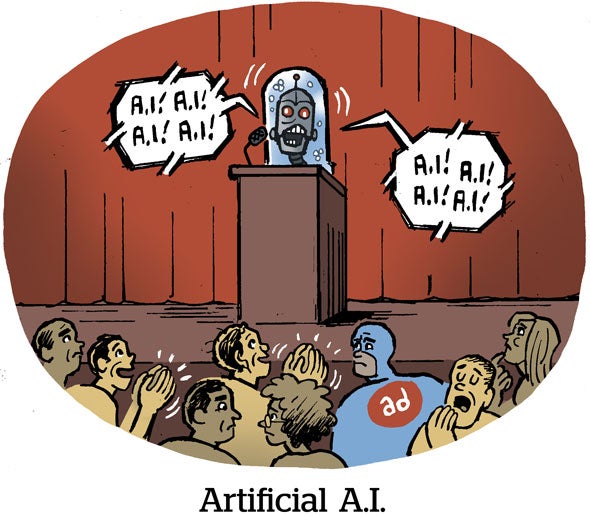Hey, readers!
Thanks for reading AdExchanger’s Commerce Media newsletter. I’m Senior Editor James Hercher, and this week we’re talking about generative AI technology and how it’s being put to use by early adopter brands.
In this case, the brand is Colgate-Palmolive, one of the highest-ranking US consumer brands in terms of household penetration, which must now figure out how to win a new type of digital shelf and product discovery.
“How will gen-AI content – while always keeping humans in the loop and always staying close to legal and IT teams – resonate or not with consumers?”
That’s the big question, according to Todd Hassenfelt, Colgate-Palmolive’s ecommerce director, who tells me that gen AI tech must carefully balance risks and rewards.
But his question also underscores how some brands are cautiously optimistic about generative AI – with an emphasis on “cautiously.”
‘Risk and reward’
The potential rewards are pretty tempting, though, especially when it comes to time and cost savings.
Colgate-Palmolive, for instance, is in a closed beta test of a generative AI product developed by Profitero, an ecommerce analytics company owned by Publicis, using the ChatGPT enterprise software.
Text-based content generation is up first, Hassenfelt said. The Profitero AI tool dynamically creates copy for product description pages.
Having a data-driven approach to product pages has become more important, Hassenfelt said.
A dynamic, tech-led approach, rather than humans rewriting product descriptions, means the copy on a page can be personalized to an individual, live trends or whichever product keywords work best with a particular retailer.
When third-party sellers on the Amazon marketplace resell Colgate-Palmolive products or cheap imitations of the brand, for example, the AI might add a bullet to the official Colgate page indicating that it’s the legit seller. But that probably isn’t something advertisers have to worry about on the Target or Walgreens site, where the main competition is more likely to be a handful of name-brand products and a private-label line rather than an ocean of third-party knockoffs.
Retailers are also inherently prioritizing product pages more by digitizing their stores, said Hassenfelt.
In some cases, screens on shopping carts or digital cards on a store shelf pull information from product pages via APIs, meaning that a retailer’s ecommerce experience is now factoring into in-store shopper decisions.
AI tech also helps “knock down the proverbial siloes” between ecommerce and creative within the CPG org, Hassenfelt said.
When data and creative people are using the same software, the art and science sides of marketing need to be aligned.
But the risks, though …
There are, however, multiple dangers brands must manage when it comes to AI tech.
The reason Colgate is testing generative AI in a closed beta with Profitero rather than diving into ChatGPT for itself is because Profitero is a tightly controlled petri dish and receives no personally identifiable information. It takes in search keywords, reviews, ratings and product descriptions, but not ID-level data or payment info.
A big difference between generative AI tech and data clean rooms, according to Hassenfelt, is the data that gets uploaded to the system for testing.
On the brand side (which is to say, from the legal perspective), there’s great caution about uploading potentially proprietary or, worse, privacy-sensitive information into AI systems.
Whereas the Amazon Marketing Cloud, a data clean room product built by AWS, ingests sensitive first-party data – giving it much higher built-in privacy protections. And generative AI tech isn’t ready to deal with those thorny privacy problems, so it doesn’t get a glance at any of that kind of data.
Not to mention the potential consumer blowback.
People are often incensed by retargeting, especially when a business spots them on a site once and then targets them with ads for weeks.
But people at least tend to understand why that’s happening. Being tracked and targeted around the web because a brand uploaded their data to a machine learning algorithm, though, would no doubt feel far more invasive.
Also, Colgate corporate would not be happy if proprietary info about its products was absorbed by an AI and used to sell some other toothpaste.
Thus, Hassenfelt said, the close involvement between legal, IT and marketing on these tests.
AI brain
Another risk is that of AI hallucinations.
Sometimes, generative AI tech can have inexplicable splinters of ideas, like saying that organic Tom’s toothpaste – a Colgate-owned brand – gives you the power to walk through walls. That’s a hypothetical example, but it’s the kind of AI hallucination that might stem from a joke review one customer left online or seemingly from nothing at all to end up confidently stated as fact by an AI chatbot.
Which means that when generative AI comes up with content or ideas, Hassenfelt said, there must be a human in the loop.
Then there’s perhaps the most important question of all: Will consumers hate or appreciate AI-generated creative?
That’s “the big unknown piece of this,” Hassenfelt said.
If Colgate-Palmolive uses generative AI creative, will brand creative across the portfolio eventually start to look and feel the same? Will consumers recognize auto-generated creative and think of potential job losses?
These are tough questions and true unknowns right now. Businesses mostly think of generative AI in terms of internal use cases and other efficiencies, according to Hassenfelt.
“But from an external standpoint,” he said, “what is the consumer reaction going to be?”














